Fauna
The animal world of Costa Rica is very rich and contains North American, South American and typically Central American components.
ANIMALS
The monkeys of Costa Rica are all great apes and are relatives of the Old World great apes, such as gorillas, chimpanzees and orangutans. However, the monkeys of the Old and New World have been separated for many millions of years and have therefore evolved differently. The monkeys of Latin America and thus also of Costa Rica are all tree dwellers with a prehensile tail as a kind of fifth limb.
Four species live in Costa Rica that are spread across the country: squirrel monkeys, howler monkeys, spider monkeys (including spider monkeys) and capuchin monkeys.
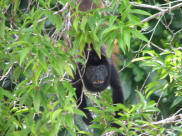 Howler Monkey
Howler Monkey  Squirrel's Head
Squirrel's Head
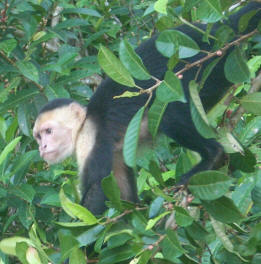 Capuchin monkey
Capuchin monkey  spidermonkey
spidermonkey
Toothless mammals such as armadillos, sloths and anteaters are common in Costa Rica.
The family of anteaters consists of three species: the giant anteater, the tamandua and the dwarf anteater.
Two species of sloth live in Costa Rica: the two-toed sloth and the three-toed sloth.
The nine-banded armadillo is found throughout Costa Rica and inhabits the most diverse ecosystems.
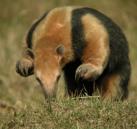 optamandua
optamandua 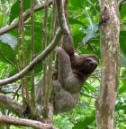 Three-toed sloth
Three-toed sloth
Feline predators from North America did not reach South and Central America until the isthmus between North and South America was created. In addition to the well-known jaguar, the following cats also live in Costa Rica: puma, ocelot, margay, and jaguarundi.
Other predators include the coati or coatis, the raccoon and the roller-tailed bear or kinkajoe.
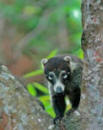 Coati
Coati  Ocelot
Ocelot  Kinkajoe
Kinkajoe
The largest mammal order in Costa Rica is that of the bats, of which there are about a hundred species. They are not only insectivores but also eat fruit, nectar, mice and frogs.
Well-known apparitions are the fishing bat, vampire bats and the tent bat
Special rodents are the agouti or gold hare and the paca. Ungulates are not very common, only a few species of dwarf deer (including Virginia deer and white-tailed deer), collared and white-lipped peccaries or bristle pigs, and tapirs.
 Pecari
Pecari  Agouti
Agouti
A remarkable appearance is the tree porcupine. In the waters of the Refugio de Fauna Silvestre Barra del Colorado in northwestern Costa Rica, the waters are teeming with sábalo or tarpon, robaló or Caribbean pike, guapote, macarela or mackerel, and the gaspar or leg pike. The gaspar is called a living fossil because this fish belongs to the order of the ray fins.
The Monteverde Cloud Forest Reserve was the only area in the world to be home to the rare sapo dorado, a golden toad. These unique animals have not been seen for several years.
 Sapo Dorado
Sapo Dorado
The Lomas Barbudal Reserve is especially important for insects. More than 250 species of bees have been counted here, as well as many species of wasps, butterflies and moths.
Parque Nacional Cahuita is important because of the coral reef that extends up to 500 meters off the coast. Dozens of coral species live there, including: moose antler coral, brain coral, fan coral or sea fan, star coral, and fire coral. Beautifully colored fish swim between the coral, such as the blue-yellow colored yellow angelfish, the black-yellow colored angelfish, the troupial fish or dukefish and the blue parrotfish. The reef is also home to barracudas, stingrays, three species of sharks and six species of moray eels
The Parque Nacional Corcovado is a rainforest area with an enormous wealth of plants and animals: 6000 species of insects, 500 species of trees, 367 species of birds, 140 mammals, 117 reptiles and amphibians and 40 species of freshwater fish have been found in the park.
BIRDS
With more than 800 bird species, of which 200 are migratory, Costa Rica is a paradise for bird watchers. The national bird of Costa Rica is the inconspicuous Gray's Thrush.
 Old postage stamp with an image of the Grays thrush
Old postage stamp with an image of the Grays thrush
The most commonly sighted birds of prey in Costa Rica are a number of vulture species: turkey vulture, black vulture and the rare king vulture. The latter bird can still be found in the Lomas Barbudal Reserve and Corcovado National Park. Of the small birds of prey, the laughing falcon is very striking, as well as the bald-legged screech owl, the pied tawny owl and the crested owl.
 Turkey
Turkey  Vulture King
Vulture King
Large waders and other waterfowl such as the roseate spoonbill, white ibis, the rare scarlet ibis, wood stork, black-bellied whistling duck, blue-winged teal and the large but rare jabiru live along slow-flowing rivers. A number of heron species are the cattle heron, the tiger heron and the barge-billed heron
 Jabiru
Jabiru 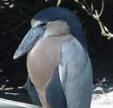 Barge Heron
Barge Heron
Special are the great frigate bird, bigua cormorant, and snake-necked bird.
Special tropical birds are the colorful trogons, including the beautiful quetzal. The quetzal was once the sacred bird of the Mayans. This bird mainly lives in the cloud forests at altitudes between 1000 and 2500 meters.
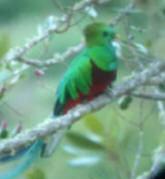 Quetzal
Quetzal
The island of Isla Bolaños (prov. Guanacaste) was declared a protected natural area in 181 for the breeding brown pelicans, American pied oystercatchers and American frigate birds. Magpie jays and black vultures are also found here.
 American Frigate
American Frigate  Bird Black Vulture
Bird Black Vulture
Toucans: Keel-breasted Toucan, Swainson's Toucan, Emerald Toucan, Green Mountain Toucan
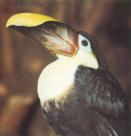 Swainson Toucan
Swainson Toucan
Hummingbirds (± 54 species): long-billed sun seeker, cerise hummingbird, violet sabre-wing hummingbird, hermit hummingbird, emerald hummingbird, tzacati amazilia, green violet hummingbird, green-crowned brilliant hummingbird, red-billed hummingbird
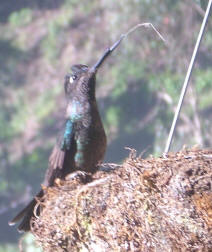 hummingbird
hummingbird
Parrots (± 20 species): red macaw, yellow-naped amazon, Salvin's amazon, small white-fronted amazon, woodpecker parrot, green aratinga, the rare scarlet macaw, crimson macaw
 scarlet macaw
scarlet macaw
Songbirds: including nuthatch, ovenbird, antbird, red-headed mannequin, weaverbird, tanager
 Ovenbird
Ovenbird  Tangara
Tangara
Special birds:
Montezuma Oropéndula, mountain blackbird, black guan (a species of bush turkey), collared arassari, striped woodpecker, bellbird, blue-capped motmot, black-browed motmot, brown hockko, red-footed rock pelican, flamed throat warbler
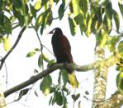 Montezuma Oropéndula
Montezuma Oropéndula 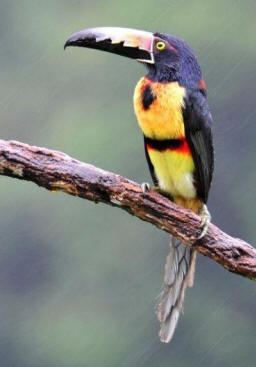 Collared arassari
Collared arassari
REPTILES AND AMPHIBIANS
Of the 135 species of snakes found in Costa Rica, seventeen are venomous. As far as venomous snakes are concerned, Costa Rica actually has two groups, the pit vipers (including the lance tip snake or fer-de-lance) and the coral snakes. The largest snake in Costa Rica is the boa constrictor, a harmless constrictor snake with a maximum length of 3.5 meters.
 Lance Point Snake
Lance Point Snake  Coral snake
Coral snake
Costa Rica has a number of impressive lizards, of which the iguanas and basilisks stand out the most. The largest iguanas are the black iguana and the green iguana. Basilisks are also iguanas, but have distinctive crests on the head, back and tail. A common reptile is the alligator lizard.
 Basilisk
Basilisk  Green iguana
Green iguana
Crocodiles:
spectacled caiman, Central American crocodile, beaked crocodile
 Spectacled Caiman
Spectacled Caiman  Crocodiles
Crocodiles
The Santa Rosa National Park is one of the most important protected natural areas of Costa Rica. On Playa Nancite, in the south of Santa Rosa, hundreds of thousands of sea turtles come ashore every year between September and December to lay eggs. Costa Rica is therefore one of the most important nesting areas for sea turtles.
The five species found in Costa Rica are the green turtle, hawksbill turtle, loggerhead turtle, warana or mongrel turtle, and leatherback turtle.
 Green sea turtle.
Green sea turtle.
More information on the sea turtles page
Frogs:
Red-eyed tree frog, poison dart frog, strawberry frog, glass frog
 Strawberry
Strawberry
 Green poison dart
Green poison dart
Fish and other marine life: sailfish, blue marlin, black marlin, yellowtail mackerel, papagallos, smooth dogfish, grunt, yellowtail, eagle ray, stingray, eel, angelfish, octopus, starfish, seahorse, whale shark, hammerhead shark, horse mackerel, spinner dolphin, pilot whale, black killer whale, spring crab
Special: lungless salamander
Insects
Costa Rica has about tens of thousands of different insect species including stick insects, termites, beach ants, praying and saber locusts. In total, about 3000 butterfly species have been counted in Costa Rica, including the beautiful blue morpho, heliconius butterfly, owlet and large pintails.



 Blue Morpho
Blue Morpho